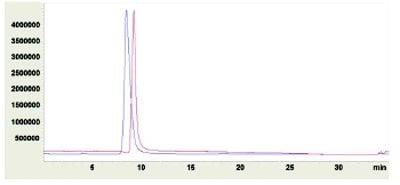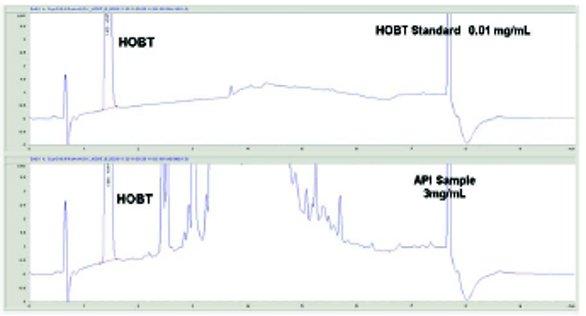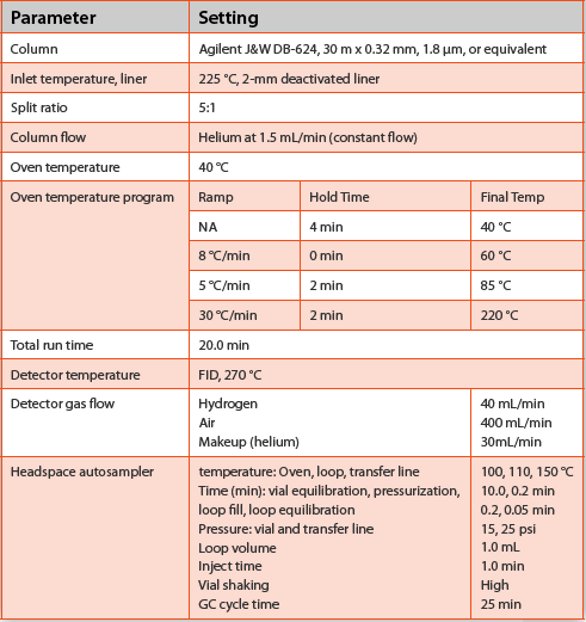Introduction
Ensuring the purity and high quality of drug substances is a critical aspect of drug development and patient safety. Organic impurities are described in international guidelines [1 – 3]. However, the guidelines are focused on the identification, qualification and specifications of impurities which are structurally related to the drug substance, or residual solvents and catalysts. Because amide and ester functional groups are ubiquitous in drug substances, we decided to address the qualification of byproducts formed from common coupling reagents used to prepare these common functional groups. In general, coupling reagents act in a similar manner by first activation of the carboxylic acid group; followed by nucleophilic attack of the amine or alcohol to form the corresponding amide or ester [4] functional group. The general scheme as shown in Figure 1 illustrates the basic amide bond forming reaction by treatment of a carboxylic acid with a coupling reagent (CR), leading to the activated complex, which is then treated with a nucleophilic amine source to form the amide bond and the coupling reagent byproduct(s).

Figure 1. Schematic illustrating the generation of an amide bond in the fi nal product and a byproduct using a coupling reagent (CR).
Selection of an effective coupling reagent is typically based on functional group selectivity, yield, and minimization of side-reactions after a screen of the readily available reagents. However, consideration of organic reaction byproducts from these reagents, which are not structurally related to the drug substance (DS), is often disregarded during development. These byproducts are often not subjected to the identification and qualification thresholds described in ICH Q3A and B [1, 2] nor are they treated the same way as residual solvents as described in ICH Q3C [3]. The specifications of these byproduct impurities can be considered individually, based on the available toxicological data, daily dose, duration of therapy, and other riskbenefit considerations. For several commonly-used coupling reagents utilized in large-scale drug manufacturing, the relevant impurities and toxicological data are summarized in Table 1. In several instances, byproducts from the coupling reagent can be formed and the known ones are listed in Table 1 after an aqueous work-up.
Table 1. Common coupling reagents, byproducts and proposed TTC for critical process parameters.

Table 1. Common coupling reagents, byproducts and proposed TTC for critical process parameters. (con’d.)

A search of the toxicology databases (e.g., Hazardous Substances Data Bank (HSDB) [5], Registry of Toxic Effects of Chemical Substances (RTECS) [6]) was conducted for each of the byproducts listed in Table 1. In most cases, toxicological data were not available. Subsequently these substances were evaluated using industry standard in silico structure-activity relationship models, SAR/(Q)SAR, (i.e. DEREK [Lhasa Ltd; Leadscope {Leadscope, Inc]) to predict potential mutagenic and/or carcinogenic activity as well as other toxicologic end points. The results from both evaluations were combined and a Threshold of Toxicologic Concern, TTC, assigned based on the approach described by Dolan et al [7]. Briefl y, the TTC principle is a level of human exposure which is estimated to pose no appreciable risk to human health for a lifetime exposure. Dolan et al derived the TTCs by analyzing the available data for regulated carcinogens and noncarcinogens to provide a scientific rationale for recommendations of acceptable limits for three classes of compounds with little or no toxicity data: (1) compounds that are likely to be carcinogenic, (2) compounds that are likely to be potent or highly toxic, and (3) compounds that are not likely to be potent, highly toxic or carcinogenic. Corresponding TTCs for these categories of materials are 1, 10 and 100 μg/day, respectively. These categories address all types of toxicological endpoints, including carcinogenicity, immunotoxicity, neurotoxicity, and developmental toxicity. The thresholds for these categories are based on the assumption that, even if subsequent testing were to indicate that, in this case the coupling agent, were to fall into one of these three categories, exposures below the TTC level pose no appreciable risk to human health. CR-byproducts in Table 1 are color coded red, yellow and green based on their designation as a Class 1, 2 or 3 compounds.
Discussion
Carbodiimide Coupling Reagents
Chemistry
Carbodiimides were the first coupling reagents to be synthesized and are still widely used. The first step in coupling involves the reaction of the carboxylic acid with the carbodiimide to form the O-acylurea. Problems with epimerization and yield have led to the development of additives such as hydroxy-benzotriazole (HOBt) [4] and other coupling reagents. The carbodiimide and resulting urea byproducts have been designed as either water soluble (e.g. EDC/ethyl-(N’,N’-dimethylamino) propyl urea) or water insoluble (e.g. DCC/dicyclohexyl urea) which infl uence the selection of reaction solvents and purification strategy.
Analysis

Figure 2. Reaction Scheme for Colorimetric Analysis of Carbodiimides
As a coupling reagent with a long history of use, methods of detection and analysis have been investigated using differing strategies from colorimetric detection to separations. Early studies were limited by the poor UV absorption focused on colorimetric analysis. Utilizing the reactivity of carbodiimides, several colorimetric assays for their detection have been developed [8, 9]. In one assay, pyridine and barbituric acid are reagents that form a brightly colored reaction product in the presence of carbodiimides. The reaction scheme is shown in Figure 2. Colorimetric assays have been shown to work with common coupling carbodiimide containing reagents such as EDC, DCC, 1-cyclohexyl-3(2-morpholinoehtyl)-carbodiimide metho-ptoluene sulfonate (CMCT) and DIC. The reaction products are detected at their maximum absorbance of 595nm. The major limitation of the colorimetric assay is that it can only detect unreacted carbodiimides while the urea byproducts are not detected. This limitation has led to the development of more modern LC-MS methodologies which used mass spectrometry for detection to overcome the poor UV absorption [10].

Figure 3. Representative Chromatograms of EDC (red) and its Urea Byproduct (blue) by Reversed Phase LC-MS with Single Ion Monitoring (SIM) Signals
LC-MS and LC-MS/MS approaches to the detection of carbodiimides are gaining popularity due to their specificity and sensitivity [11]. Typically, these methods are set up as limit tests to demonstrate that the EDC and its urea byproduct have been sufficiently purged from the process. Due to the rapid reactivity of EDC during sample preparation and analysis, EDC and its corresponding urea byproduct are generally summed to yield the total carbodiimide. Figure 3 shows representative chromatograms for EDC and its urea byproduct. This method demonstrated the ability to separate and detect EDC and the urea byproduct.
Instrument: UHPLC with single quadrupole MS. Column: C18; mobile phase, isocratic 98% 200mM Ammonium Formate pH 4 and 2% Acetonitrile ; column temperature 10°C; Detection, SIM mode, EDC at 156 amu and urea byproduct at 174 amu. Note: The EDC and urea signals were normalized to appear on the same scale
Onium Coupling Reagents
Chemistry
Several coupling reagents are based on the HOBt/substituted HOBt systems and onium salts. These reagents react with carboxylic acids to form active esters, which then react with amines [4]. A side-reaction can often take place where the amine reacts with the coupling reagent to form a guanidinium byproduct, thus order of addition and timing are crucial. Reactions are generally rapid with little epimerization.

Figure4. Representative Chromatogram of HOBt by Reversed Phase HPLC with UV Detection

Figure 5. Representative Chromatogram of PF6- by Reversed Phase HPLC with CAD and UV Detection Note that PF6- is not detected by UV.

Figure 6. Representative Chromatogram of TMU by Head Space-GC with FID Detection [12] Showing Other Common Solvents in a Generic Method for Residual Solvent Analysis
Analysis
Methods to determine residual Hydroxyl-benzotriazole (HOBt), tetramethylurea (TMU) and PF6- in API were developed in our laboratories. HOBt was determined using Reversed Phase HPLC with UV detection; PF6- was determined using Reversed Phase HPLC with CAD (Charged Aerosol Detection).TMU was determined with Head Space-GC using FID Detection. The method development was challenging due to the range of products involved and poor UV absorption. Representative chromatograms with chromatographic conditions are presented in: Figure 4 for HOBt, Figure 5 for PF6- determination and Figure 6 for TMU with chromatographic conditions summarized in Table 2.
Table 2. GC-Headspace Parameters for Determination of [12].

Column: C18 3um 100x3.0 mm; Mobile Phase: A 20 mM ammonium formate pH 3.7, B Acetonitrile; Gradient: 10 to 30% in 3 min, 30 to 100% B in 3 min, hold at 100% B for 1 minute; Column Temp: 40 oC; Flow rate: 1.0 mL/min; UV Detector: 310 nm; Sample Concentration: 3 mg/mL of API in 50:50 ACN/water; Injection Volume: 20 μL
Column: C18 3 μm 150 x 4.6 mm; Mobile Phase A: 20 mM ammonium formate pH 3.7, Mobile Phase B: 0.05% formic acid in Acetonitrile; Gradient: 15 to 40% B in 25 min, 40 to 90% B in 3 min; Column Temp: 30 oC; Flow rate: 1.0 mL/min; Inj Vol: 5 μL; UV Detector: 280 nm and CAD; Sample Concentration: 1.0 mg/mL of API in 50:50 ACN/water; Injection Volume: 10 μL
Other Coupling reagents
1,1’-carbonyldiimidazole (CDI)
Chemistry
The search for coupling reagents better than carbodiimides has led to the development of CDI (1,1’-carbonyldiimidazole) and related carbonylimidazoles [12]. For practical considerations, it should be noted that moisture must be carefully excluded during work with CDI and that stoichiometric excess should be avoided.
Table3. Method Validation Data Summary for Residual Imidazole in API

Analysis
A method to determine residual imidazole in API was developed using mixed-mode HPLC. The method development was challenging due to the relatively low molecular weight and high polarity. Method validation is summarized in Table 3 and a representative chromatogram with chromatographic conditions is presented in Figure 7.
Column: Mixed mode embeded acetic ion-pairing, 2x50 mm, 5 μm; Mobile Phase A: 0.05% trifl uoroacetic acid (TFA) in water, Mobile Phase B: 0.05% TFA in Acetonitrile; Gradient: Hold at 50% B for 1.5 min, 50- 80% in 1.5 min, hold at 80% for 0.5 min; Column Temp: 35 oC; Flow rate: 1.0 mL/min; UV Detector: 205 nm; Sample Concentration: 10.0 mg/mL of API in 50:50 ACN/water; Injection Volume: 10 μL.
Propylphosphonic Anhydride (T3P)
Chemistry
T3P Coupling agent is used due to the high yields with low epimerization. They pose little health or environmental risk, and the resulting byproducts allow for simple phase extraction. T3P converts the oxygen of a carboxylic acid into an ionic leaving group, which is extracted from the product. T3P compares favorably to other coupling agents with respect to: yields, epimerization rates, overall process costs, and safety/toxicity [13].

Figure 7. Representative Chromatogram of Imidazole by Mixed Mode HPLC with UV Detection
Analysis
 An LC-MS (negative ionization mode) method to determine residual Propylphosphonic acids in API was developed using Reversed-Phase HPLC. The sensitive detection of the analytes required LC-MS due to their relatively low UV absorbance. Although the method is capable of resolving mono, di and tri propylphosphonic acids; the predominant residual product was found to be the mono acid. A representative chromatogram with chromatographic conditions is presented in Figure 8.
An LC-MS (negative ionization mode) method to determine residual Propylphosphonic acids in API was developed using Reversed-Phase HPLC. The sensitive detection of the analytes required LC-MS due to their relatively low UV absorbance. Although the method is capable of resolving mono, di and tri propylphosphonic acids; the predominant residual product was found to be the mono acid. A representative chromatogram with chromatographic conditions is presented in Figure 8.

Figure 8. Representative Chromatogram of Propyl Phosphoric Acids by Reversed Phase LC-MS with Total Ion Current (TIC) Signal and Corresponding Mass Spectrum
Column: C18, 150 mm x 4.6 mm, 3 μm; Mobile Phase A: 20 mM Ammonium Formate buffer, pH 3.7, Mobile Phase B: 0.05% Formic acid in Acetonitrile; Gradient: 98-5% Bottle A in 8 min, hold at 5% for 2 min; Column Temp: 30 oC; Flow rate: 0.8 mL/min; Inj Vol: 20 mL; Sample Concentration: 1.0 mg/mL of API in 50:50 Mobile Phase A/ Mobile Phase B; Injection Volume: 10 μL; MS Detection: Source: ESI, Mode: Single Ion Monitoring (SIM Ion 335.10, 229.10 and 123.00), Polarity: Negative.
Conclusion
Coupling reagents are widely used to form amides and esters for the synthesis of active pharmaceutical ingredients (API). Consideration of the reaction byproducts of these reagents are often disregarded during process development since the byproducts are not structurally related to the drug substance. This paper discusses the origin, toxicological evaluation and testing methods for reaction byproducts from many commonly-used coupling reagents including: carbodiimides, aminium-based, phosphorous-based reagents as well as simple coupling reagents such as 1,1-carbonyldiimidazole (CDI). This information should prove useful to others facing similar challenges for assessment and control of these byproduct impurities.
Author biographies
Dr. Larry Wigman is an Analytical Chemist by training with his doctorate from Duke University, under the direction of the late Charles Lochmuller. Larry has held various positions including: Senior Research Scientist at Pfizer, Manager at Mylan, Associate Director at Sanofi, Principal Consultant at Regulitics LLC; and, most recently Senior Scientifi c Manager of the Small Molecule Analytical Chemistry and Quality Control Group at Genentech.
Dr. Travis Remarchuk is a scientist in the Small Molecule Process Chemistry group at Genentech. Prior to joining Genentech, he was a postdoctoral fellow at Harvard University. He received his PhD in organic chemistry from the University of California Irvine.
Dr. Stephen Gomez is a Senior Manager in Product Quality & Occupational Toxicology within Genentech Safety Assessment. He has over 20 years of experience in occupational, environmental and inhalation toxicology, and, health-based risk assessment in support of pharmaceutical development. Stephen received his Ph.D. degree in Toxicology from Cornell University.
Dr. Archana Kumar is associate scientist in Small Molecule Analytical Chemistry and Quality Control group at Genentech where she is responsible for leading analytical and quality support for early development projects from preclinical to phase 2 and then transfer. She holds a Ph.D. degree in organic chemistry from Syracuse University.
Dr. Michael W. Dong is a Sr. Scientist with Small Molecule Analytical Chemistry and Quality Control. in Genentech responsible for new analytical technologies, late-stage research support and automation. He has 100+ publications and 3 books and is a member of the editorial board of American Pharmaceutical Review.
Dr. Colin D. Medley received his Ph.D. in Analytical Chemistry from the University of Florida while focusing on aptamer nanoparticle conjugates and biosensors. He has focused on analytical method development for various conjugated proteins and the small molecule components of antibody drug conjugates.
Dr. Nik Chetwyn is head of the Small Molecule Analytical Chemistry and Quality Control group at Genentech. Prior to joining Genentech, he was an Associate Director at Pfizer and a Research Investigator at GlaxoSmithKline. Nik received his Ph.D. from the University of Kansas.
References
- ICH, Q3A (R), Impurities in New Drug Substances (Feb. 2003)
- ICH, Q3B (R), Impurities in Drug Products (Nov. 2003)
- ICH, Q3C (R5), Impurities: Guideline for Residual Solvents (March 2011)
- Valeur E., and Bradley, M., Chem. Soc. Rev. 38 (2009) 606–631.
- Hazardous Substances Data Bank (HSDB), United States National Library of Medicine, (http://toxnet.nlm.nih.gov/cgibin/ sis/htmlgen?HSDB)
- Registry of Toxic Effects of Chemical Substances (RTECS), Centers for Disease Control and Prevention, (http://www.cdc.gov/niosh/ rtecs/default.html)
- Dolan, D.G., Naumann, B.D., Sargent, E.V., Maier, A., Dourson, M., Regulatory Toxicology and Pharmacology, 43 (2005) 1-9.
- Wilchek, M., Miron, T., and Kohn, J., Anal. Biochem. 114 (1981) 419-421.
- Jacobson, B.S., and Fairman, K.R., Anal. Biochem. 106 (1980) 114-117.
- Lei, Q.P., Lamb, D.H., Shannon, A.G., Cai, X., Heller, R.K., Huang, M., Zablackis, E., Ryall, R., and Cash, J. Chromatogr. B, 813(1-2) (2004) 103-112.
- Lulu D., Quiroga, A. C., Zhang, K., Runes, H. B., Yazzie, D. T., Mistry, K., Chetwyn, N.P, and Dong, M. W. LCGC North America , 28 (1)(2010)54-66.
- Staab, H. A., Angew. Chem. Int. Ed. Engl. 1(7) (1962) 351-367.
- Hiebl, J., Alberts, D.P., Banyard, A.F., Baresch, K., Baumgartner, H., Bernwieser, I., Bhatnagar, P.K., Blanka, M., Bodenteich, M., Chen, T., Esch, P.M., Kollmann, H., Lantos, I., Leitner, K., Mayrhofer, G., Patel, R., Rio, A., Rovenszky, F., Stevenson, D., Tubman, K.D., Undheim, K., Weihtrager, H., Welz, W., and Winkler, K., J Pept Res. 54(1) (1999), 54-65.